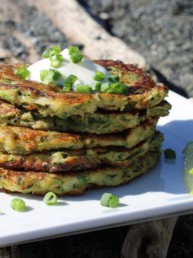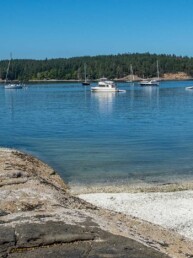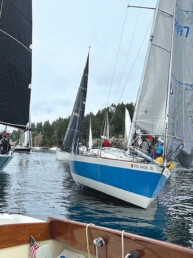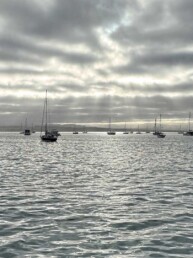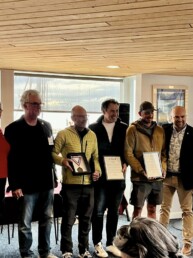This article originally appeared in the June 2021 issue of 48° North.
For many cruisers, us included, sailing our vessels from one port to another is in our bones. Or is it? Being driven by the wind isn’t essential to cruising. Along the way during our years afloat, cruisers exploring under power shaped some very important parts of our experience. Importantly, these lessons remind us of what’s universal in the cruising culture and that differences in propulsion type hardly define us as cruisers, friends, and stewards of the ocean and our communities.
Cruising Culture: Grey Wolf
Jamie introduced me to the concept of cruising, and set the hook of our dream by introducing me to the couple who would become our mentors — Jim and Diana Jessie. One summer in the mid-1990s, we drove down to Baja California to meet up with the Jessies for island-hopping adventures.
Anchored in Puerto Don Juan, a call came over the VHF one morning: Grey Wolf, a powerboat across the bay, was having engine trouble. The owner discovered the issue and found the replacement part among his engine spares. Unfortunately, the box containing the spare showed the correct part number, but held a part made for a different engine. He was dead in the water and a long way from, well, anywhere with the right part.
A collection of cruisers came together on the deck of the Grey Wolf and spent the afternoon working to fashion an adaptor that would get the engine to run again. It was literally a process of making a Franken-filter — the ingredients a mix of parts and ingenuity supplied from several cruising boats.
This bias to share resources in a remote place, to give of time and energy and scarce materials — without expectation — left an impression on me. It remains one of the unspoken tenets of cruising culture I value most highly to this day, and has shown true across all types of vessels.
 Figuring Out Homeschooling: Oso Blanco
Figuring Out Homeschooling: Oso Blanco
Homeschooling gave me more anxiety than any other single aspect of cruising, both in anticipation and in our early years. If I’m honest, it still does, although we’ve now demonstrated that we managed not to screw it up (our boatschooled oldest is a junior at Lewis & Clark College, and doing great).
Three months into our cruising adventure, I was deeply stressed about our homeschooling path. Sitting on a beach in San Diego, my friend Annie talked me down. She called a powerboat home — the Nordhavn 64, Oso Blanco — and had cruised tens of thousands of miles. I dumped my fears in her experienced lap. She talked through my worries, and promised me it would be OK. In ways subtle and overt, she helped me overcome homeschooling hurdles for years.
With the perspective of time, I realize this anxiety is common. It’s just hard to pop up the periscope and recognize when you’re living it every day. I needed a homeschooling mentor, and she happened to cruise under power.
Sharing the Experience: Furthur
In Mexico, we encountered Furthur, a Selene 48 with a homeport of Friday Harbor and a row of dancing bears painted on the transom. The owner, Brian, is a confirmed free spirit who left Puget Sound to find adventure… and didn’t want to be a singlehander. Absent a partner, he formed his own merry band(s) along the way, bringing numerous crew aboard over the years.
There were usually at least two crew at any given time aboard Furthur. Even Niall joined for a leg in Indonesia, boarding in Bali and sailing (well, motoring) ahead of us for a few days before rejoining Totem at islands near Lombok. There are themes in Brian’s style and crew, but my favorite is their enthusiasm for sharing adventures and creating memories. It’s no accident that some of our standout memories include Furthur’s captain and crew — celebrating Australia Day in Sydney Harbor aboard Furthur; or being serenaded by a man with flying fingers (he turned out to be from Blue Man Group, incognito on holiday) on a little island in Indonesia.
Brian and the Furthur crew’s proactive efforts to invite experiences into everyday life lies at the heart of the best of cruising. We don’t cruise to tick off a bucket-list of places, passages, or achievements. We’re here to share the water, to share experiences, and bring positivity to life.
 Matching boat with intentions: Muscat
Matching boat with intentions: Muscat
Setting off from Australia in 2012, we entered a new chapter in our cruising journey. With a topped up kitty and commitment to avoid resuming mainstream life, we sailed north for Papua New Guinea. Early on, we met Gary and Bev, freshly departed from Queensland for their second round of cruising. The Australian couple had previously sailed a trimaran through Southeast Asia, spending several years winding though Indonesia, Malaysia, and Thailand before returning to Oz and moving ashore. When it was time to go again, they chose a power cat — Muscat 2.
In Budi Budi atoll, Bev gave me a tour of the boat they fondly referred to as an “Aquabago”. The spacious accommodation (they hosted our crew of five and another family of five for Christmas lunch – and had room to spare!) and a full-size kitchen (Gary’s a restauranteur) were impressive for a boat we recall as around 40 feet in length!
They had been diehard sailors, so why did they buy a powerboat? Despite the great light-air performance of their trimaran, they still spent a lot of time motoring. In Southeast Asia, that’s the norm: there’s often very little wind near the equator. With no plans to be in tradewind regions, the power cat was a great fit for regional cruising. It reminded Jamie and I that we could consider the same switch, should we call Salish Sea waters home again. You still have to pick your tide for Cattle Pass, but it’s a lot easier to make progress from A to B (and manage multi-season cruising) under power.
As much as sailors like to think about themselves being different from powerboaters, we have vastly more in common than the few areas we differ. Engineless cruisers might be the outliers, but they are a few-and-far-between exception to the typical cruiser. It’s no surprise that — while we use the white flappy things and maintain a genuine and deep appreciation for the ability to harness the wind — so many of our cruising lessons have been learned from our power-driven counterparts. The most important stuff in life and cruising transcends our small differences and reminds us we really are one big community.
This month Totem is doing a turn as an engineless boat while sorting out options for repowering to be a hybrid sail/power vessel again!
Behan and Jamie Gifford
Behan and Jamie Gifford set sail from Bainbridge Island in 2008 and are currently aboard Totem in Mexico. Their column for 48° North has traced Lessons Learned Cruising during a circumnavigation with their three children aboard and continued adventures afloat. Follow them at www.sailingtotem.com

